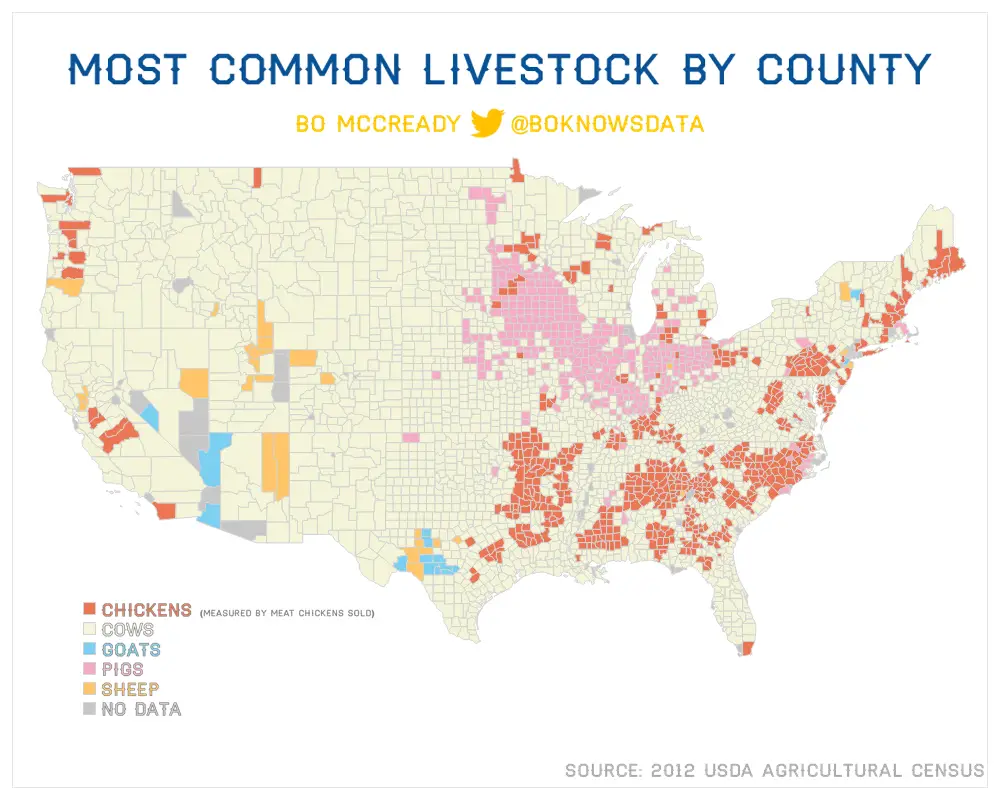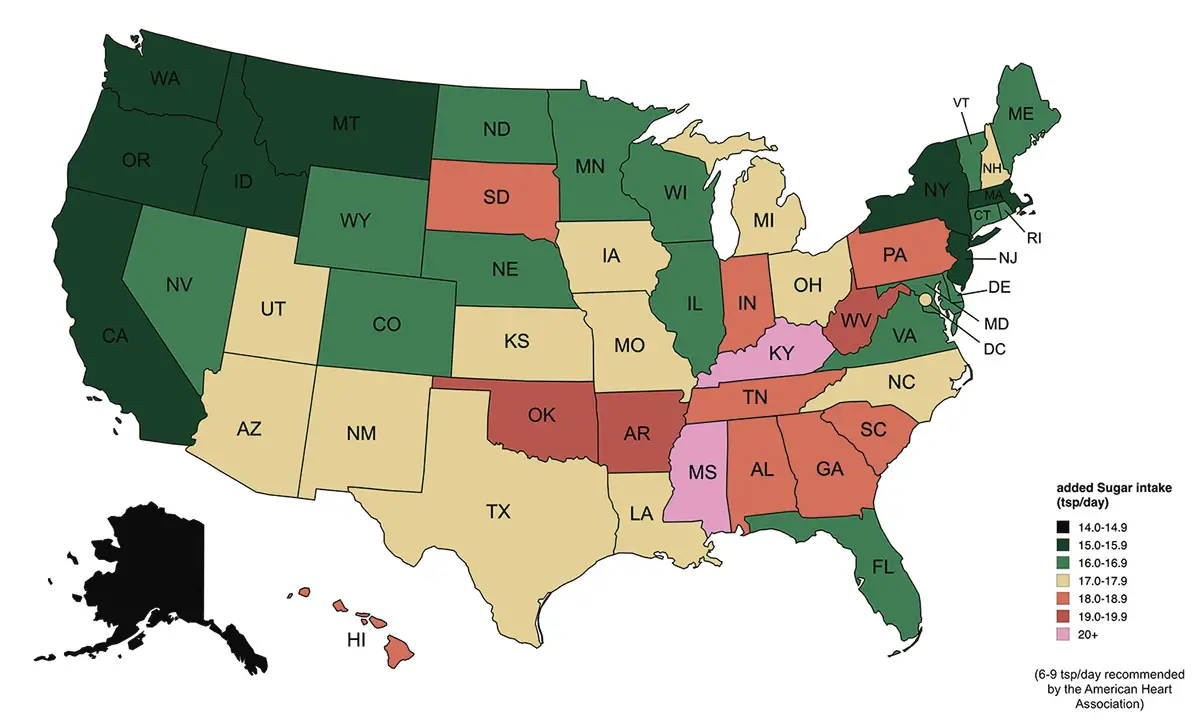World Map of Livestock Density
Together, meat, dairy, and eggs constitute almost 18% of an individual’s everyday dietary intake.
However, to bring these meat and animal products to consumers, a colossal worldwide livestock sector, which sustains the livelihoods of 1.3 billion individuals worldwide, over 600 million among the world’s poorest and most vulnerable farmers and pastoralists, functions in fields and farms that are predominantly concealed from major urban centers.
What are the geographical distribution of the diverse livestock breeds worldwide, and how does national consumption behavior affect livestock farming?
The world maps created using the Gridded Livestock of the World database from the UN Food and Agriculture Organization by Adam Symington will help to answer this question.
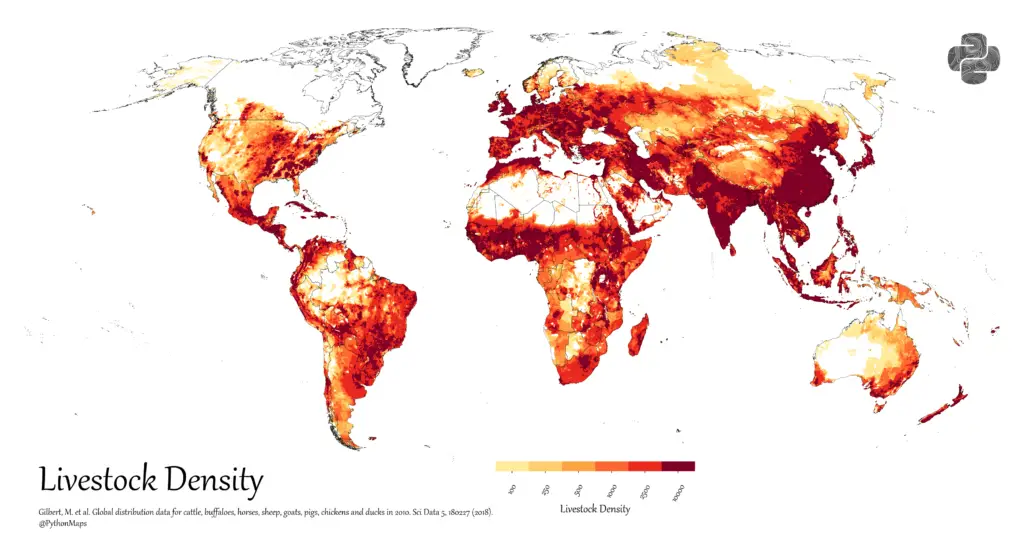
Cattle Density
Cattle density worldwide can vary significantly from region to region due to a multitude of factors. Cattle density is influenced by a combination of natural, social, and economic factors, including climate, land availability, cultural practices, and the demand for beef and dairy products.
Cattle density is often concentrated in specific regions known for their favorable conditions for livestock rearing. These regions typically have abundant pasturelands, suitable climates, and a long history of livestock farming. Examples of such regions include the Pampas in South America, the Great Plains in North America, the Sahel in Africa, and parts of Central Asia.
In certain countries, cattle density tends to be higher in coastal regions compared to inland areas. This is often due to the availability of fertile land, milder climates, and access to water resources near coastlines. Coastal regions may also have better transportation infrastructure, making it easier to transport livestock and livestock products to markets.
Cattle density tends to be lower in mountainous and hilly regions due to the challenges associated with livestock management in such terrain. Steep slopes and rugged landscapes can limit the availability of suitable grazing land and water sources, making it more difficult to maintain high cattle densities.
In regions where transhumance or nomadic herding is practiced, cattle density can vary seasonally. Pastoralist communities may move their herds to higher elevations during the summer and to lower elevations during the winter, resulting in varying cattle densities in different areas throughout the year.
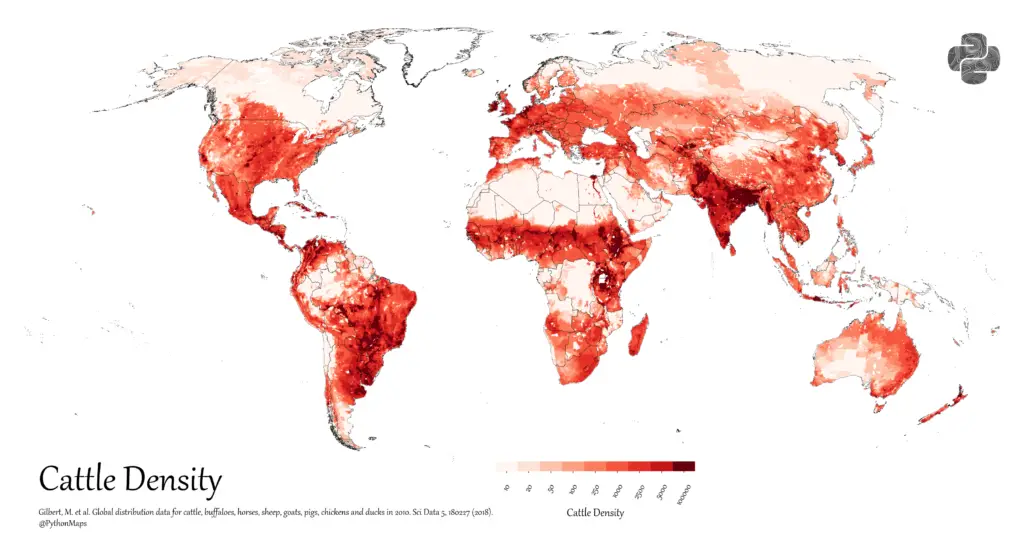
Cattle density can be influenced by political and economic factors, including land tenure systems, government policies, and investment in the livestock sector. Some countries may have large cattle populations and high density due to strong government support and incentives for livestock production.
In certain regions, cultural and religious practices can affect the geographical distribution of cattle density. For example, in India, cattle are considered sacred, leading to a relatively high cattle density despite challenges related to land availability and population density.
As urbanization and land use changes occur, cattle density may decrease in some regions due to the conversion of agricultural land into urban areas or other purposes. Urban expansion can lead to the reduction of available grazing land and a shift away from traditional livestock farming practices.
Pig Density
The geographical distribution of pig density is strongly influenced by regional pork consumption patterns. In countries and regions where pork is a staple in the diet and enjoys widespread popularity, pig density tends to be higher. Conversely, in regions where pork consumption is limited or culturally restricted, pig density may be lower.
East Asia, especially China, stands out as a dominant region with high pig density. China is the largest pork producer and consumer in the world, accounting for a significant portion of global pig farming. The popularity of pork in East Asian cuisines has driven the demand for pigs and influenced their distribution in the region.
High pig density regions often rely on intensive pig farming methods to meet the demand for pork. Intensive pig farming involves raising large numbers of pigs in confined spaces, using advanced husbandry practices to maximize production efficiency. Such intensive systems are common in regions where pork consumption is high and where there is a need to produce pigs on a large scale.
Some countries or regions with relatively lower pig density play a significant role as pork exporters. These countries may specialize in pig production for export markets and contribute to the global supply chain. For example, certain European countries, such as Denmark and Spain, are known for exporting pork products to various regions worldwide.
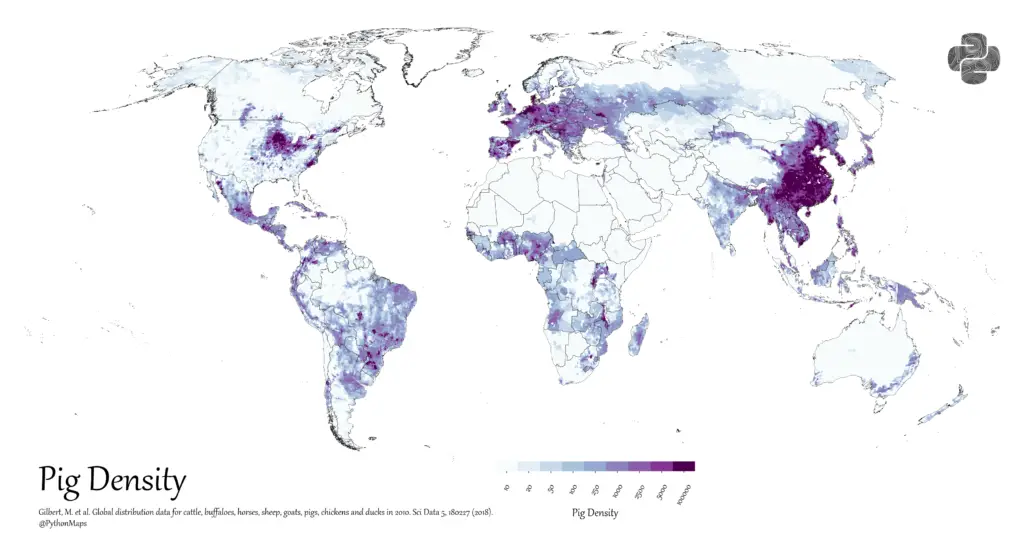
Pig density can be influenced by religious beliefs and cultural practices that either encourage or restrict pig farming. In regions where religious or cultural norms prohibit the consumption of pork, pig density may be low or even absent. Conversely, in regions where pork is an integral part of cultural and culinary traditions, pig density tends to be higher.
Chicken Density
The geographical distribution of chicken density worldwide exhibits unique patterns due to a combination of cultural preferences, dietary habits, economic factors, and the suitability of the environment for poultry farming. Chickens are one of the most widely farmed and consumed livestock globally, and their distribution is influenced by various region-specific factors.
Asia is the dominant region with the highest chicken density in the world. Countries like China, India, Indonesia, and Vietnam have significant chicken populations. Poultry, especially chicken, is an essential source of affordable protein in many Asian diets, leading to substantial chicken farming and consumption in the region.
In high-density regions, intensive poultry production is common. This method involves raising a large number of chickens in confined spaces, typically in commercial farms, with controlled feeding and management to maximize production efficiency. Intensive systems are prevalent in regions with high demand for poultry products and where the industry needs to meet the population’s protein needs.
While chicken is popular worldwide, the highest chicken consumption per capita is often found in Western countries, such as the United States, Brazil, and some European nations. Despite this high consumption, the geographical distribution of chicken density may not be as dense as in some Asian countries. This is due to variations in farming practices and production systems.
In many rural and developing regions, chicken farming is prevalent at the small-scale or backyard level. Families and communities often raise chickens for household consumption and as a source of additional income. This decentralized approach to chicken farming contributes to a scattered distribution of chicken density in these areas.
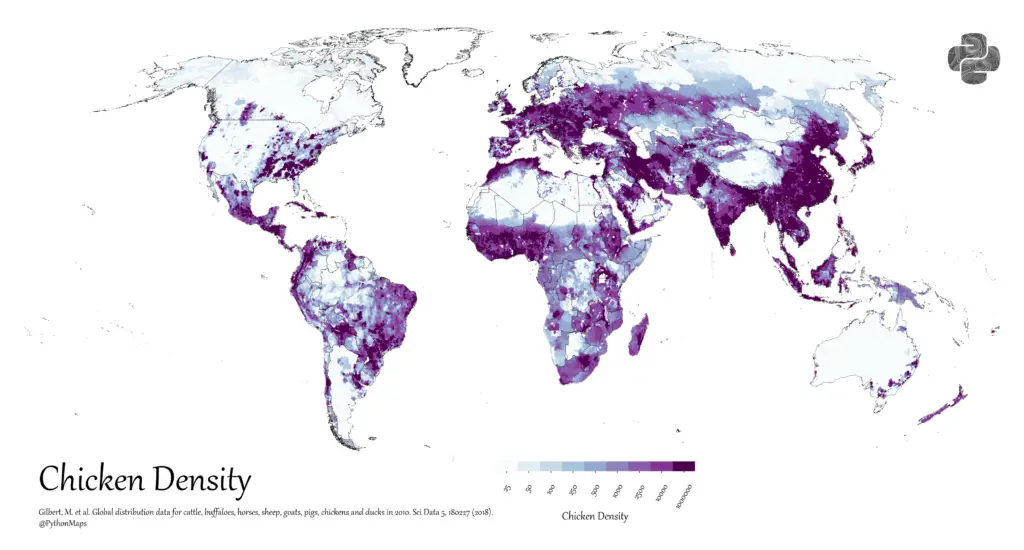
Religion and cultural practices can influence the geographical distribution of chicken density. In countries with predominantly Muslim or Jewish populations, poultry farming may be more prevalent due to the permissibility of consuming chicken, while pig farming (which is restricted in these religions) may be less common.
Sheep Density
Sheep have been domesticated for thousands of years and have adapted to a wide range of environments, which has contributed to their presence in diverse regions.
Sheep density tends to be concentrated in specific regions known for their long-standing sheep-rearing traditions and favorable environmental conditions for grazing. For example, parts of Central Asia, the Middle East, the Mediterranean region, and the British Isles have a rich history of sheep farming and, consequently, higher sheep densities.
Sheep are well-suited to graze in mountainous and hilly regions, and as a result, sheep density can be relatively high in these areas. The ability of sheep to graze on rough and less fertile terrains makes them valuable for producing meat and wool in such landscapes.
In some regions, sheep density may fluctuate seasonally due to nomadic or transhumant herding practices. Nomadic pastoralist communities in various parts of the world, such as Central Asia and parts of Africa, move their flocks over long distances in search of better grazing areas.
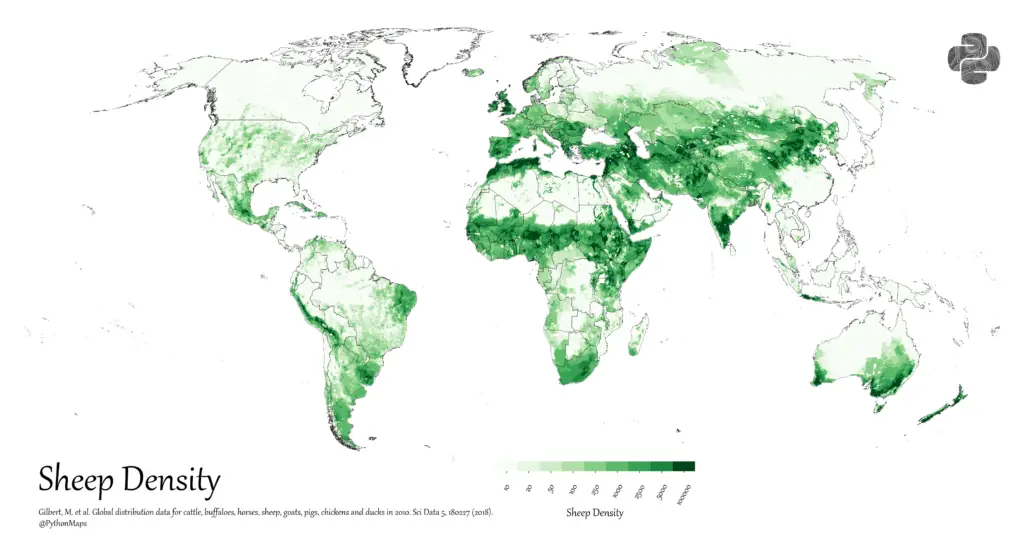
The distribution of sheep density can also be influenced by cultural traditions and practices. In some regions, sheep hold significant cultural importance and are used in traditional ceremonies, rituals, and social events. This cultural significance can impact the number of sheep kept in certain areas.
Goat Density
The geographical distribution of goat density worldwide exhibits peculiar patterns that are also influenced by a combination of cultural practices, economic factors, environmental conditions, and the versatility of goats as livestock.
Goats are well-suited to thrive in arid and semi-arid regions where other livestock may struggle due to limited water and forage resources. As a result, goat density tends to be higher in such areas, including parts of Africa, the Middle East, Central Asia, and certain regions of the Indian subcontinent.
Goats are highly adaptable to a wide range of environments, including mountainous and hilly terrains. Their ability to graze on rough and less fertile land makes them valuable for producing food and other products in these landscapes.
Goat density can fluctuate seasonally due to nomadic or pastoralist herding practices. Many pastoralist communities in various regions, such as parts of Africa and Central Asia, practice seasonal migration, moving their goat herds in search of better grazing areas.
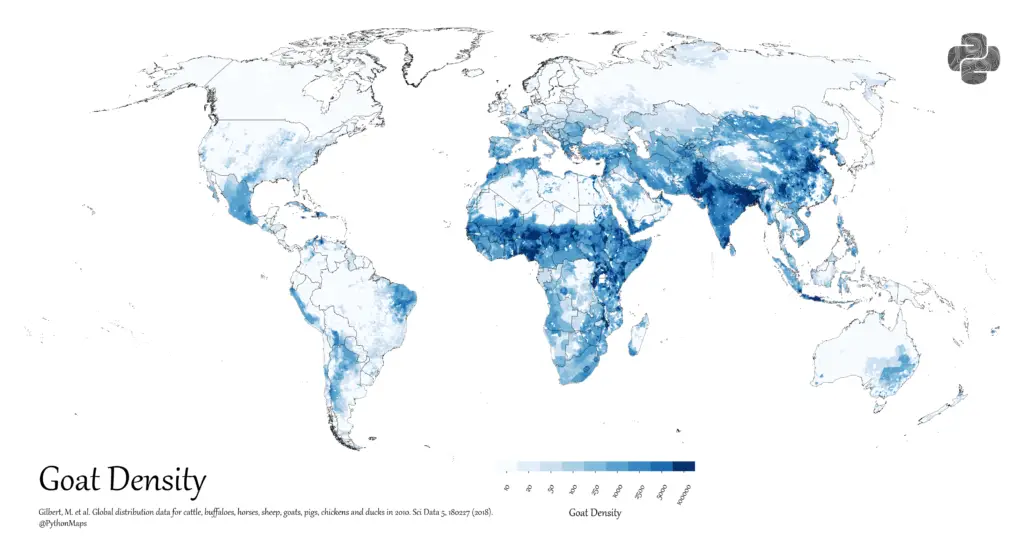
In some regions, goats hold significant cultural and traditional importance. They may be used in rituals, religious ceremonies, and social events, leading to a higher concentration of goats in certain areas.
Goats are valued for both milk and meat production. In regions where goat milk is a dietary staple or used for traditional dairy products, goat density tends to be higher. Similarly, areas with a higher demand for goat meat (chevon or mutton) may have higher goat densities.
Duck Density
Duck farming is often associated with wetland areas, as ducks require access to water for swimming, feeding, and nesting. Regions with abundant wetlands, such as lakes, rivers, and marshes, may have higher duck livestock density due to the availability of suitable habitats.
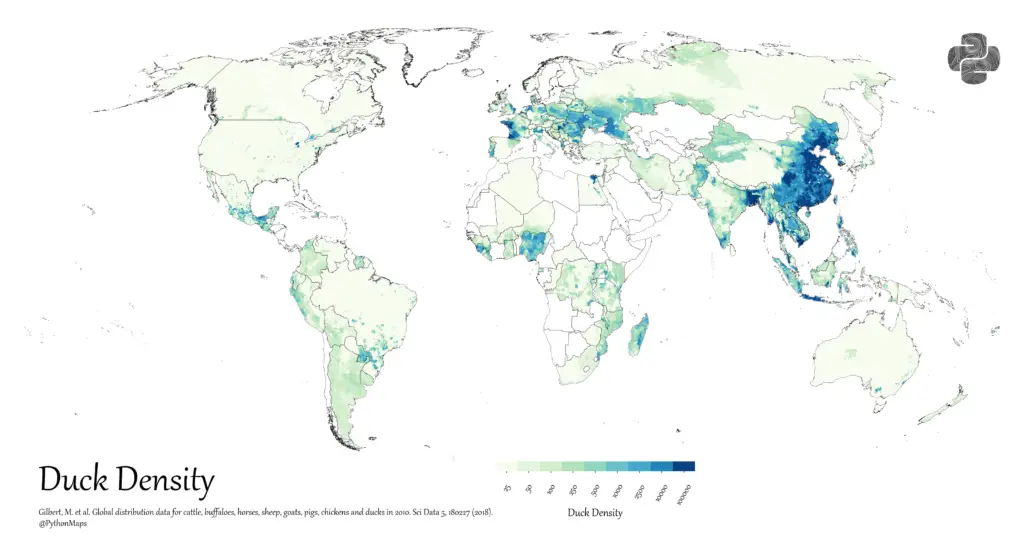
Duck meat and eggs are widely consumed in many cultures, especially in East and Southeast Asia. In regions where duck meat is a staple in the diet or has cultural significance, duck livestock density tends to be higher. Countries like China, Vietnam, Thailand, and Indonesia have notable duck farming industries due to the popularity of duck-based dishes.
In some Asian countries, traditional rice-duck farming systems are practiced. Ducks are allowed to forage in rice paddies after the harvest, providing pest control services and fertilizing the fields with their droppings. These systems can contribute to higher duck livestock density in certain regions.
In some areas, particularly in rural and smallholder farming systems, backyard duck farming is prevalent. Families and communities may keep a few ducks for personal consumption or as a supplementary source of income, contributing to localized duck livestock density.
To learn more about livestock and farming, you may be interested in the following books:

